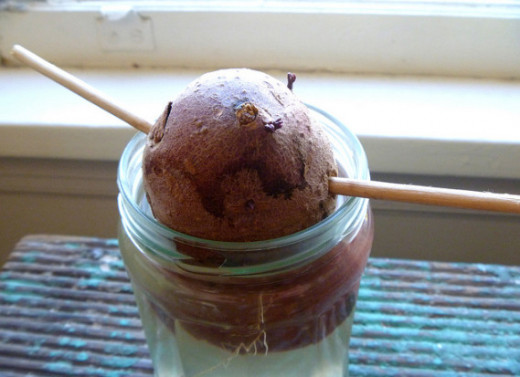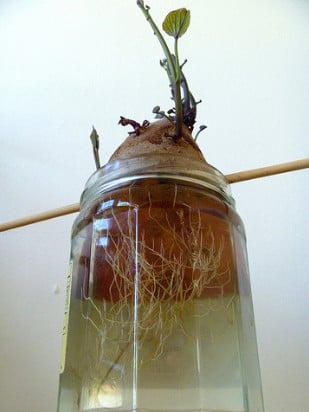How to Grow Sweet Potatoes – From Slips to Tuber



Growing sweet potatoes
This Hub will cover the process of growing sweet potatoes. You will learn how to grow sweet potato slips and how to plant them on to give you bountiful harvests. I will also cover how to grow them in colder climates – even here in the UK (hardiness zones ranging from 7 to 10).
My Fascination with Sweet Potatoes
When I took on my allotment (community garden in the US), we were only allowed to buy seed potatoes from one source because blight was a persistent problem. No matter how early in the year I went to buy my seed potatoes, they were always sold out. I only have a small vegetable patch in my home garden, and was basically limited to growing potatoes in containers. Because my household is predominantly self-sufficient, this was not enough. We needed a staple supply of satisfying complex carbohydrates, like tubers. I started investigating alternatives to the humble potato and experimenting with what would grow in my climate (hardiness zone 9). It has been a long and exciting journey, unearthing many rare and wonderful potato alternatives. Most are easy to grow in temperate climates (more Hubs about them soon). But I thought I would start my first Hub with one of the most difficult tubers to grow in my zone, sweet potatoes.
What are Sweet Potatoes?
Sweet potatoes are perennial vines native to the tropical regions of America. The flowers and foliage are reminiscent of bindweed, so it is no surprise that sweet potatoes come from the same Convolvulaceae family. Starchy and sweet, the tubers need around 5 to 6 months of warm weather to grow. It is for this reason I recommend growing under cover if you are in colder climes.
How to Grow Sweet Potato Slips
Sweet potatoes are started from slips – shoots grown directly from the tuber. You can find sweet potato slips for sale, but they are often pretty expensive to buy; growing your own is actually fairly easy from shop bought tubers. The problem with growing sweet potato slips in cooler climates is that the shop bought ones are not necessarily bred for these environments. But in my experience as a grower, there is only a small difference between growing sweet potatoes bred for cooler climates, and growing slips from grocery store tubers. This is because if you are growing sweet potatoes in the UK (or the cooler parts of the US and Europe) you are fighting an uphill battle, regardless of the variety. Sweet potatoes really need at the very least 21C (69F) for 3 months and that is just in the main stage of growth.
To grow the slips yourself you will need several glass jars, some tooth picks, water, and healthy sweet potatoes of your choice.
1) Make sure your sweet potatoes fit widthways into your glass jar.
2) About midway down the sweet potato insert 3 or 4 tooth picks, making sure they are equally spaced around the circumference. Try to ensure about half of each toothpick is left sticking out.
3) Fill your glass jars with water and submerge half of the sweet potato into the jar. Use the inserted toothpicks to balance the sweet potato on the rim of the jar.
Leave the jar in a warm and sunny location. A windowsill or greenhouse is good, but in cooler climates the greenhouse would need to be heated. In about 2 to 7 days you should start seeing several sprouts growing on the tuber. The jar will also fill up with roots. Be sure to keep the jar topped up with water.
How to Plant Sweet Potato Slips
After about 4 weeks, when the sprouts are about 5 inches long, it is time to remove them. Pull gently very closely to where the shoot is growing from the tuber. Giving a little sideways wiggle should ensure that the shoot comes away cleanly. Leave the sweet potato in the jar of water and it should continue to produce slips.
Take all the slips and add them to another jar of water, and leave it in a warm sunny spot. After a few days, these sweet potato slips should start to form roots of their own. After a week or two the roots should be long enough for you to pot on or plant out.
At this stage there are 3 options. Which one you proceed with will depend on your climate.
1) If you live in an area that will have at least 4 months at 21C (minimum), you can plant them directly outside into their growing positions. Keep them watered whilst they establish.
2) If you are going to grow them in a heated greenhouse, you can plant them directly into their growing spot. Keep them watered whilst they establish.
3) For those with shorter summers, pot the rooted slips on in 1 liter pots. This will allow for strong vigorous growth and extend the season.
For cooler climates timing is crucial. The whole process from sprouts to rooted slips will take about 6 to 10 weeks. Whether you pot them on, or plant directly into their growing positions in a greenhouse, they need another 3 to 5 months after that.
I normally start mine at the end of February by a warm windowsill. By May, I have many rooted slips, which I then add to large pots and leave to grow in a heated greenhouse until about mid June or July (depending on how temperatures are panning out that year), before I plant them outdoors into their growing positions. I also always have a small batch growing directly in my heated greenhouse.
How to Grow Sweet Potatoes
Sweet potatoes need a minimum of 21C to grow, and need to be spaced 18 inches apart when placed in their final growing position. If you are growing them outdoors in temperate climates, harden the plants off for about a week or two before planting out, and wait until all risk of frost has passed. Add a sheet of black plastic to the ground they will be growing in, several weeks before planting out, and plant through the plastic. Plant them into deeply worked, fertile soil. Also add cloches around your sweet potato plants if you are in a temperate climate. Keep them watered whilst they establish themselves.
I do not want to get your hopes up. Best results for growing sweet potatoes in temperate climates are in greenhouses and polytunnels. Outdoor grown sweet potatoes in my climate are a bit 'touch and go'. Sometimes they do surprisingly well. Other times they do not. But for me, always, outdoor grown sweet potatoes are much smaller than you would expect. See the video below for some idea of what to expect.
Climates
There is no doubt sweet potatoes can be challenging to grow in temperate climates. For me, I grow them for the novelty factor, rather than as a worthwhile crop. They are certainly not a crop you should emotionally invest in, but it is possible to grow them in colder climes. This year has been unusually cold, so I am not expecting much from them, they really have struggled. But when it works, it is worth the effort. Good luck!



